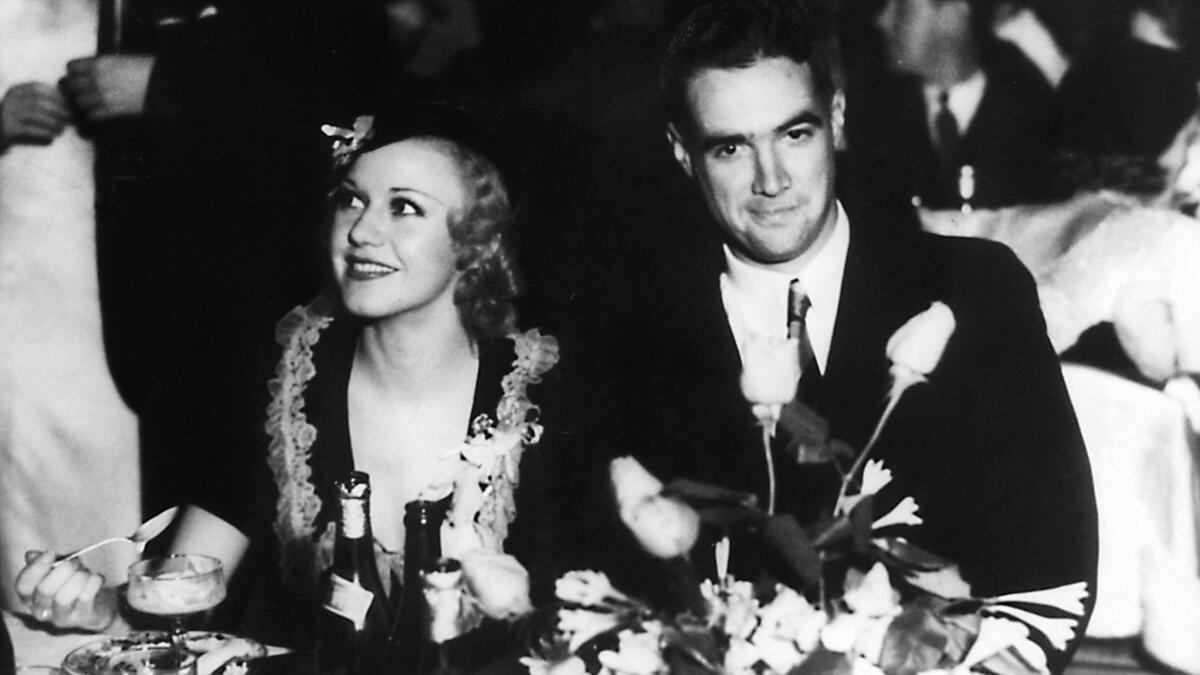Classic Hollywood’s glory and sins, distilled through the women around Howard Hughes

- Share via
Every person who intersected with Howard Hughes — and he intersected with almost every major figure of his era — had their own version of the man. Ava Gardner’s version is not Katharine Hepburn’s version, or Jean Harlow’s version, or Jane Russell’s version.
Hughes “was enthusiastic about only four things: money, movies, aircraft, and beautiful young women with beautiful breasts. Which, obviously, is where I came in,” Gardner wrote in “Ava: My Story.”
But then here’s Hepburn from “Me”: “We were a colorful pair. It seemed logical for us to be together. ... Certainly I felt that I was madly in love with him. ... Ambition beat love, or was it like?”
Depending on whom you listen to, Hughes was a villain, a genius, a madman, sometimes all three simultaneously. His Hollywood career, in particular, is difficult to pin down. He strolls through so many Hollywood memoirs he takes on Zelig-like proportions. Is there anyone he didn’t meet, or date, or lock into a bungalow making her wait for her big break?
In her new book, “Seduction: Sex, Lies, and Stardom in Howard Hughes’s Hollywood,” Karina Longworth puts all of the stories from countless memoirs together in one place, allowing the conflicting versions of Howard Hughes to stand side by side, revealing his desire for control, sex and fame, and in so doing she creates a vibrant history not just of Hughes but of Hollywood itself, its sins and glories, its darkness and light.
As Longworth observed in a 2016 interview in the Guardian, “[Howard Hughes] is a rubric to tell the story of a lot of fascinating women. He arrives in Hollywood in 1925 and starts to disappear in the 1950s, so you can use him to tell the story of Hollywood in that era.”
Longworth got her start as a film critic, writing reviews for Time Out New York, the Village Voice, New York Magazine and other outlets. After a stint as the film editor of LA Weekly, she launched “You Must Remember This,” a “storytelling podcast about the secret and/or forgotten histories of Hollywood’s first century.” What began as a passion project for Longworth quickly became essential listening to anyone interested in film history, as well as one of the top podcasts on iTunes as a whole. Longworth devotes seasons to exploring different aspects of Hollywood history — the Hollywood Blacklist, Charles Manson, fact-checking Kenneth Anger’s “Hollywood Babylon.” In the seventh episode of the podcast, airing June 27, 2014, Longworth started a series called “The Many Loves of Howard Hughes,” where she describes Hughes’ transformation from “a big-spending hayseed to Hollywood big shot.” It was the germ of “Seduction.”
While fascinating in its past particulars, “Seduction” is also a very timely book. In recent years the entertainment industry has been rocked by scandal, the #MeToo movement shattering the code of silence around the still-existing “casting couch.”
Harvey Weinstein’s appalling behavior is the most obvious example. As story after story came out, it became increasingly clear that one of the most tragic byproducts of all of this was the sidelining of actress’ careers who refused to play along. We now have a terrible answer to the question “Why don’t Ashley Judd and Mira Sorvino work more?” Longworth visits this territory over and over again in “Seduction,” writing, “Howard Hughes was not the only mogul in Hollywood who profited off treating actresses as sex goddess flavors of the month ... Hughes did the same things that other men did — he just did them more crudely.”
Howard Hughes arrived in Hollywood as a restless young millionaire from Texas, looking to make a splash in the movie industry during the tail-end of the silent film era. He spent years (and millions) making the aviation epic “Hell’s Angels,” which was nominated for an Academy Award for cinematography and made Jean Harlow a superstar. Hughes then produced Howard Hawks’ 1932 gangster film “Scarface,” running afoul of censorship boards due to its violence and amorality. This would not be Hughes’ last run-in with censors. A pioneer in more ways than one, he realized the value of bad publicity. His track record in Hollywood was spotty, at best. He only directed two films, “Hell’s Angels” and 1943’s “The Outlaw,” starring Jane Russell and her extremely prominent cleavage. Hughes’ controlling treatment of the actresses he put under personal contract was an open secret in Hollywood at the time, the scope of which was only hinted at in Martin Scorsese’s 2004 biopic “The Aviator.” Longworth brings Hughes’ compulsive behavior with these women front and center.
“Seduction” is broken up into different chapters detailing Hughes’ relationships (professional and otherwise) with actresses Billie Dove, Jean Harlow, Katharine Hepburn, Ginger Rogers, Jane Russell, Faith Domergue, Ava Gardner, etc. The book is a compulsive page-turner, written with a wisecracking style (“[Hughes] had cooked up this cockamamie scheme...”) that also manages to be serious and thoughtful.
Longworth does not pull her punches, going after the male power structure itself with no-nonsense zingers: “[David O.] Selznick really believed Katharine Hepburn was not good-looking enough to be in movies, and, unable to imagine a movie viewer responding to an actress whom Selznick himself wasn’t sexually attracted to, he figured A Bill of Divorcement was doomed with her in it.”
Using Hughes as the focal point, Longworth provides mini-profiles of many forgotten female figures who deserve to be remembered outside the small circle of Hollywood film buffs. People like writers Anita Loos, Sheilah Graham, Adela Rogers St. Johns and director Lois Weber. Much of “Seduction” reads like a long overdue act of redress, repositioning women into the more central positions where they belong.
In some of the best sequences of the book, Longworth brings her film critic’s eye to the subject at hand, providing analysis of the films (and actresses) mentioned. On Jean Harlow in 1933’s “Bombshell,” Longworth writes: “In Bombshell, you love her and root for her in every scene, while also laughing at her. By the end of the film, we understand that Hollywood is the only place for a girl like Lola.” Or, on Ava Gardner’s introduction in 1946’s “The Killers”: “In a masterfully lit medium shot, she dominates the frame, giving moviegoers their first real chance to contemplate Ava Gardner’s odd, imperfect, beauty: the dimple in her chin, the puffiness in the cheeks and under the eyes. Moments later, we finally get a real close-up on Ava, and it’s intense. We quickly cut away, as if the editor of the movie has taken on the persona of Swede, who’s afraid of what might happen if he looks for too long. He should be afraid.” This is very fine! “Seduction” will surely inspire readers who haven’t seen these films to go seek them out as quickly as possible.
One look at Longworth’s bibliography gives a sense of the scope of her research, as well as her painstaking methodology. She hasn’t just relied on memoirs and official biographies. She has also dug deep into the archives of long-defunct movie magazines, poring through gossip pages, movie scrapbooks and blind items written as the events unfolded in real time. One of Longworth’s footnotes describes an item in the collection of silent star Billie Dove: “In handwritten notes on a copy of a biographical article about her written by DeWitt Bodeen in the magazine Films in Review, which stated her birth year in 1901, [Billie] Dove crossed out the year and wrote ‘Mother and Father hadn’t met yet,’ but she did not supply her ‘correct’ birth year.” A writer has to really care about her subject to scour through handwritten scribbles like this. Longworth squints into the archives, trying to read between the lines, to hear the voices of these women, discover their experiences and bring them into the light.
While Longworth treats Hughes’ mental struggles with appropriate sympathy, she never lets you forget the women whose lives were often derailed by their run-ins with him. This is a book about Hollywood and so it is a book about male power run unchecked.
In his unfinished final novel, “The Last Tycoon,” F. Scott Fitzgerald wrote, famously, “You can take Hollywood for granted like I did, or you can dismiss it with the contempt we reserve for what we don’t understand. It can be understood too, but only dimly and in flashes. Not half a dozen men have ever been able to keep the whole equation of pictures in their heads.” Not half a dozen women, either. But in “Seduction,” with its fluid intersecting narratives of sex, greed, fame and creation, Karina Longworth comes close.
O’Malley is a regular film critic for Rogerebert.com. Her work has also appeared in the New York Times, Film Comment, the Criterion Collection and Sight & Sound. Her personal site is the Sheila Variations.
“Seduction: Sex, Lies, and Stardom in Howard Hughes’s Hollywood”
Karina Longworth
Custom House: 560 pp., $29.99
More to Read
Sign up for our Book Club newsletter
Get the latest news, events and more from the Los Angeles Times Book Club, and help us get L.A. reading and talking.
You may occasionally receive promotional content from the Los Angeles Times.






